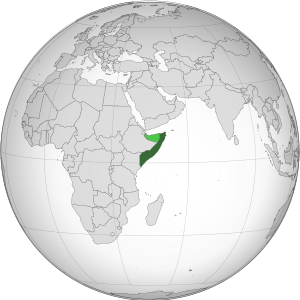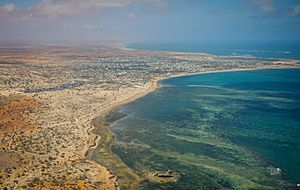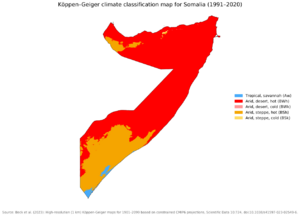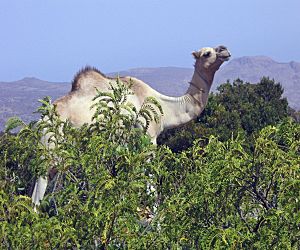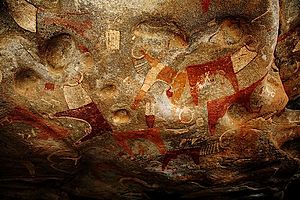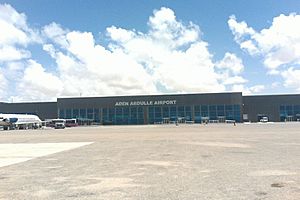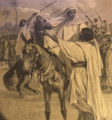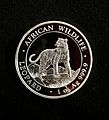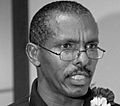Somalia facts for kids
Quick facts for kids
Federal Republic of Somalia
|
|
|---|---|
|
Anthem: Qolobaa Calankeed
علم أي امة "Every Nation Has Its Own Flag" |
|
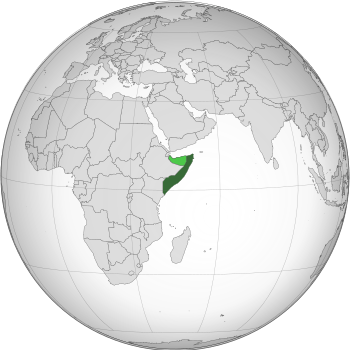 |
|
| Capital and largest city
|
Mogadishu 2°2′N 45°21′E / 2.033°N 45.350°E |
| Official languages | |
| Ethnic groups
(2021)
|
|
| Religion | Sunni Islam (official) |
| Demonym(s) | Somali |
| Government | Federal parliamentary republic |
| Hassan Sheikh Mohamud | |
| Hamza Abdi Barre | |
|
• Speaker of the Senate
|
Abdi Hashi Abdullahi |
| Legislature | Federal Parliament |
| Senate | |
| House of the People | |
| Establishment | |
| 2350 BC | |
|
• Macrobia
|
980 BC |
|
• Barbaria
|
100 BC |
|
• Adal Sultanate
|
9th century |
|
• Mogadishu Sultanate
|
10th century |
| 13th century | |
| 13th century | |
|
• Hiraab Imamate
|
16th century |
|
• Geledi Sultanate
|
1695–1911 |
|
• Majeerteen Sultanate
|
1648–1927 |
|
• Sultanate of Hobyo
|
1878–1927 |
|
• Isaaq Sultanate
|
1749–1884 |
| 1884 | |
|
• Italian Somaliland
|
1889 |
|
• Independence and union with the State of Somaliland
|
1 July 1960 |
| Area | |
|
• Total
|
637,657 km2 (246,201 sq mi) (43rd) |
| Population | |
|
• 2023 estimate
|
18,143,378 (78th) |
|
• Density
|
27.2/km2 (70.4/sq mi) (199th) |
| GDP (PPP) | 2024 estimate |
|
• Total
|
|
|
• Per capita
|
|
| GDP (nominal) | 2023 estimate |
|
• Total
|
|
|
• Per capita
|
|
| Gini (2017) | 36.8 medium |
| HDI (2022) | low · 193rd |
| Currency | Somali shilling (SOS) |
| Time zone | UTC+3 (EAT) |
| Driving side | right |
| Calling code | +252 |
| ISO 3166 code | SO |
| Internet TLD | .so |
Somalia (Somali: Soomaaliya; Arabic: الصومال) is officially the Republic of Somalia (Somali: Jamhuuriyadda Soomaaliya; Arabic: جمهورية الصومال). It was previously known as the Somali Democratic Republic. It is a country in the Horn of Africa. It is bordered by Djibouti to the northwest, Kenya to the southwest, the Gulf of Aden with Yemen to the north, the Indian Ocean to the east, and Ethiopia to the west.
Contents
History
In antiquity, Somalia was an important commercial center. During the Middle Ages, several powerful Somali empires dominated the regional trade, including the Ajuran Sultanate, Adal Sultanate, and the Sultanate of the Geledi. In the late 19th century, Somali sultanates were colonized by the Italian and British Empires, who merged all of these tribal territories into two colonies: Italian Somaliland and British Somaliland. In 1960, the two territories united to form the independent Somali Republic under a civilian government. Siad Barre of the Supreme Revolutionary Council (SRC) seized power in 1969 and established the Somali Democratic Republic, brutally attempting to squash the Somaliland War of Independence in the north of the country. The SRC collapsed in 1991 with the onset of the Somali Civil War. The Transitional National Government of Somalia (TNG) was established in 2000, followed by the formation of the Transitional Federal Government of Somalia (TFG) in 2004, which reestablished the Somali Armed Forces.
At the end of 2006, a US-backed Ethiopian invasion overthrew the Islamic Courts Union (ICU), leading to the installation of the TFG in Mogadishu under an Ethiopian military occupation. The subsequent insurgency which emerged saw the ICU fragment into various rebel factions, including the hardline group al-Shabaab, which waged a protracted conflict against Ethiopian forces. al-Shabaab soon began asserting territorial control for the first time, and by late 2008 the insurgency had driven the Ethiopian army out of much of Somalia. In 2009, a new TFG government was established. By mid-2012, al-Shabaab lost most of its territories during fighting against the TFG and African Union troops. That same year, al-Shabaab pledged allegiance to Al-Qaeda. The insurgents still control much of central and southern Somalia, and wield influence in government-controlled areas, with the town of Jilib acting as the de facto capital for the insurgents.
Geography
Somalia is bordered Djibouti to the northwest, Ethiopia to the west, the Gulf of Aden to the north, the Somali Sea and Guardafui Channel to the east, and Kenya to the southwest. With a land area of 637,657 square kilometers, Somalia's terrain consists mainly of plateaus, plains and highlands. Its coastline is more than 3,333 kilometers in length, the longest of mainland Africa. It has been described as being roughly shaped "like a tilted number seven".
In the far north, the rugged east–west ranges of the Ogo Mountains lie at varying distances from the Gulf of Aden coast. Hot conditions prevail year-round, along with periodic monsoon winds and irregular rainfall. Geology suggests the presence of valuable mineral deposits. Somalia is separated from Seychelles by the Somali Sea and is separated from Socotra by the Guardafui Channel.
Administrative divisions
Somalia is officially divided into eighteen regions (gobollada, singular gobol), which in turn are subdivided into districts. The regions are:
| Region | Area (km2) | Population | Capital |
|---|---|---|---|
| Awdal | 21,374 | 1,010,566 | Borama |
| Bari | 70,088 | 949,693 | Bosaso |
| Nugal | 26,180 | 473,940 | Garowe |
| Mudug | 72,933 | 864,728 | Galkayo |
| Galguduud | 46,126 | 634,309 | Dusmareb |
| Hiran | 31,510 | 566,431 | Beledweyne |
| Middle Shabelle | 22,663 | 622,660 | Jowhar |
| Banaadir | 370 | 2,330,708 | Mogadishu |
| Lower Shabelle | 25,285 | 1,218,733 | Barawa |
| Togdheer | 38,663 | 962,439 | Burao |
| Bakool | 26,962 | 383,360 | Xuddur |
| Woqooyi Galbeed | 28,836 | 1,744,367 | Hargeisa |
| Bay | 35,156 | 1,035,904 | Baidoa |
| Gedo | 60,389 | 566,318 | Garbahaarreey |
| Middle Juba | 9,836 | 432,248 | Bu'aale |
| Lower Juba | 42,876 | 632,924 | Kismayo |
| Sanaag | 53,374 | 578,092 | Erigavo |
| Sool | 25,036 | 618,619 | Las Anod |
Northern Somalia is now de facto divided up among the autonomous regions of Puntland (which considers itself an autonomous state), Somaliland (a self-declared but unrecognized state) and newly established Khatumo State of Somalia. In central Somalia, Galmudug is another regional entity that emerged just south of Puntland. Jubaland in the far south is a fourth autonomous region within the federation. In 2014, a new South West State was likewise established. In April 2015, a formation conference was also launched for a new Hirshabelle State.
The Federal Parliament is tasked with selecting the ultimate number and boundaries of the autonomous regional states (officially Federal Member States) within the Federal Republic of Somalia.
Location
Somalia is bordered by Kenya to the southwest, the Gulf of Aden to the north, the Guardafui Channel and Indian Ocean to the east, and Ethiopia to the west. The country borders Djibouti. It lies between latitudes 2°S and 12°N, and longitudes 41° and 52°E. Strategically located at the mouth of the Bab el Mandeb gateway to the Red Sea and the Suez Canal, the country occupies the tip of a region that, due to its resemblance on the map to a rhinoceros' horn, is commonly referred to as the Horn of Africa.
Waters
Somalia has the longest coastline on the mainland of Africa, with a seaboard that stretches 3,333 kilometres (2,071 mi). Its terrain consists mainly of plateaus, plains and highlands. The nation has a total area of 637,657 square kilometres (246,201 sq mi) of which constitutes land, with 10,320 square kilometres (3,980 sq mi) of water. Somalia's land boundaries extend to about 2,340 kilometres (1,450 mi); 58 kilometres (36 mi) of that is shared with Djibouti, 682 kilometres (424 mi) with Kenya, and 1,626 kilometres (1,010 mi) with Ethiopia. Its maritime claims include territorial waters of 200 nautical miles (370 km; 230 mi).
Somalia has several islands and archipelagos on its coast, including the Bajuni Islands and the Saad ad-Din Archipelago: see islands of Somalia.
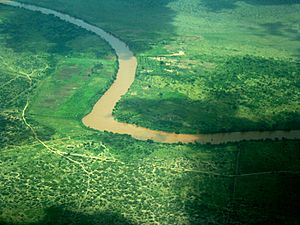
Habitat
Somalia contains seven terrestrial ecoregions: Ethiopian montane forests, Northern Zanzibar–Inhambane coastal forest mosaic, Somali Acacia–Commiphora bushlands and thickets, Ethiopian xeric grasslands and shrublands, Hobyo grasslands and shrublands, Somali montane xeric woodlands, and East African mangroves.
In the north, a scrub-covered, semi-desert plain referred as the Guban lies parallel to the Gulf of Aden littoral. With a width of twelve kilometres in the west to as little as two kilometres in the east, the plain is bisected by watercourses that are essentially beds of dry sand except during the rainy seasons. When the rains arrive, the Guban's low bushes and grass clumps transform into lush vegetation. This coastal strip is part of the Ethiopian xeric grasslands and shrublands ecoregion.
Cal Madow is a mountain range in the northeastern part of the country. Extending from several kilometres west of the city of Bosaso to the northwest of Erigavo, it features Somalia's highest peak, Shimbiris, which sits at an elevation of about 2,416 metres (7,927 ft). The rugged east–west ranges of the Karkaar Mountains also lie to the interior of the Gulf of Aden littoral. In the central regions, the country's northern mountain ranges give way to shallow plateaus and typically dry watercourses that are referred to locally as the Ogo. The Ogo's western plateau, in turn, gradually merges into the Haud, an important grazing area for livestock.
Somalia has only two permanent rivers, the Jubba and Shabele, both of which begin in the Ethiopian Highlands. These rivers mainly flow southwards, with the Jubba River entering the Indian Ocean at Kismayo. The Shabele River at one time apparently used to enter the sea near Merca, but now reaches a point just southwest of Mogadishu. After that, it consists of swamps and dry reaches before finally disappearing in the desert terrain east of Jilib, near the Jubba River.
Environment

Somalia is a semi-arid country with about 1.6% arable land. The first local environmental organizations were Ecoterra Somalia and the Somali Ecological Society, both of which helped promote awareness about ecological concerns and mobilized environmental programs in all governmental sectors as well as in civil society. From 1971 onward, a massive tree-planting campaign on a nationwide scale was introduced by the Siad Barre government to halt the advance of thousands of acres of wind-driven sand dunes that threatened to engulf towns, roads and farm land. By 1988, 265 hectares of a projected 336 hectares had been treated, with 39 range reserve sites and 36 forestry plantation sites established. In 1986, the Wildlife Rescue, Research and Monitoring Centre was established by Ecoterra International, with the goal of sensitizing the public to ecological issues. This educational effort led in 1989 to the so-called "Somalia proposal" and a decision by the Somali government to adhere to the Convention on International Trade in Endangered Species of Wild Fauna and Flora (CITES), which established for the first time a worldwide ban on the trade of elephant ivory.
Later, Fatima Jibrell, a prominent Somali environmental activist, mounted a successful campaign to conserve old-growth forests of acacia trees in the northeastern part of Somalia. These trees, which can live for 500 years, were being cut down to make charcoal which was highly in demand in the Arabian Peninsula, where the region's Bedouin tribes believe the acacia to be sacred. However, while being a relatively inexpensive fuel that meets a user's needs, the production of charcoal often leads to deforestation and desertification. As a way of addressing this problem, Jibrell and the Horn of Africa Relief and Development Organization (Horn Relief; now Adeso), an organization of which she was the founder and executive director, trained a group of teens to educate the public on the permanent damage that producing charcoal can create. In 1999, Horn Relief coordinated a peace march in the northeastern Puntland region of Somalia to put an end to the so-called "charcoal wars". As a result of Jibrell's lobbying and education efforts, the Puntland government in 2000 prohibited the exportation of charcoal. The government has also since enforced the ban, which has reportedly led to an 80% drop in exports of the product. Jibrell was awarded the Goldman Environmental Prize in 2002 for her efforts against environmental degradation and desertification. In 2008, she also won the National Geographic Society/Buffett Foundation Award for Leadership in Conservation.
Following the massive tsunami of December 2004, there have also emerged allegations that after the outbreak of the Somali Civil War in the late 1980s, Somalia's long, remote shoreline was used as a dump site for the disposal of toxic waste. The huge waves that battered northern Somalia after the tsunami are believed to have stirred up tons of nuclear and toxic waste that might have been dumped illegally in the country by foreign firms.
The European Green Party followed up these revelations by presenting before the press and the European Parliament in Strasbourg copies of contracts signed by two European companies — the Italian Swiss firm, Achair Partners, and an Italian waste broker, Progresso — and representatives of the then President of Somalia, the faction leader Ali Mahdi Mohamed, to accept 10 million tonnes of toxic waste in exchange for $80 million (then about £60 million).
According to reports by the United Nations Environment Programme (UNEP), the waste has resulted in far higher than normal cases of respiratory infections, mouth ulcers and bleeding, abdominal haemorrhages and unusual skin infections among many inhabitants of the areas around the northeastern towns of Hobyo and Benadir on the Indian Ocean coast — diseases consistent with radiation sickness. UNEP adds that the situation along the Somali coastline poses a very serious environmental hazard not only in Somalia, but also in the eastern Africa sub-region.
Climate
Owing to Somalia's proximity to the equator, there is not much seasonal variation in its climate. Hot conditions prevail year-round along with periodic monsoon winds and irregular rainfall. Mean daily maximum temperatures range from 30 to 40 °C (86 to 104 °F), except at higher elevations along the eastern seaboard, where the effects of a cold offshore current can be felt. In Mogadishu, for instance, average afternoon highs range from 28 to 32 °C (82 to 90 °F) in April. Some of the highest mean annual temperatures in the world have been recorded in the country; Berbera on the northwestern coast has an afternoon high that averages more than 38 °C (100 °F) from June through September. Nationally, mean daily minimums usually vary from about 15 to 30 °C (59 to 86 °F). The greatest range in climate occurs in northern Somalia, where temperatures sometimes surpass 45 °C (113 °F) in July on the littoral plains and drop below the freezing point during December in the highlands. In this region, relative humidity ranges from about 40% in the mid-afternoon to 85% at night, changing somewhat according to the season. Unlike the climates of most other countries at this latitude, conditions in Somalia range from arid in the northeastern and central regions to semiarid in the northwest and south. In the northeast, annual rainfall is less than 100 mm (4 in); in the central plateaus, it is about 200 to 300 mm (8 to 12 in). The northwestern and southwestern parts of the nation, however, receive considerably more rain, with an average of 510 to 610 mm (20 to 24 in) falling per year. Although the coastal regions are hot and humid throughout the year, the hinterland is typically dry and hot.
There are four main seasons around which pastoral and agricultural life revolve, and these are dictated by shifts in the wind patterns. From December to March is the Jilal, the harshest dry season of the year. The main rainy season, referred to as the Gu, lasts from April to June. This period is characterized by the southwest monsoons, which rejuvenate the pasture land, especially the central plateau, and briefly transform the desert into lush vegetation. From July to September is the second dry season, the Xagaa (pronounced "Hagaa"). The Dayr, which is the shortest rainy season, lasts from October to December. The tangambili periods that intervene between the two monsoons (October–November and March–May) are hot and humid.
Wildlife
Somalia contains a variety of mammals due to its geographical and climatic diversity. Wildlife still occurring includes cheetah, lion, reticulated giraffe, baboon, serval, elephant, bushpig, gazelle, ibex, kudu, dik-dik, oribi, Somali wild ass, reedbuck and Grévy's zebra, elephant shrew, rock hyrax, golden mole and antelope. It also has a large population of the dromedary camel.
Somalia is home to around 727 species of birds. Of these, eight are endemic, one has been introduced by humans, and one is rare or accidental. Fourteen species are globally threatened. Birds species found exclusively in the country include the Somali Pigeon, Alaemon hamertoni (Alaudidae), Lesser Hoopoe-Lark, Heteromirafra archeri (Alaudidae), Archer's Lark, Mirafra ashi, Ash's Bushlark, Mirafra somalica (Alaudidae), Somali Bushlark, Spizocorys obbiensis (Alaudidae), Obbia Lark, Carduelis johannis (Fringillidae), and Warsangli Linnet.
Somalia's territorial waters are prime fishing grounds for highly migratory marine species, such as tuna. A narrow but productive continental shelf contains several demersal fish and crustacean species. Fish species found exclusively in the nation include Cirrhitichthys randalli (Cirrhitidae), Symphurus fuscus (Cynoglossidae), Parapercis simulata OC (Pinguipedidae), Cociella somaliensis OC (Platycephalidae), and Pseudochromis melanotus (Pseudochromidae).
There are roughly 235 species of reptiles. Of these, almost half live in the northern areas. Reptiles endemic to Somalia include the Hughes' saw-scaled viper, the Southern Somali garter snake, a racer (Platyceps messanai), a diadem snake (Spalerosophis josephscorteccii), the Somali sand boa, the angled worm lizard, a spiny-tailed lizard (Uromastyx macfadyeni), Lanza's agama, a gecko (Hemidactylus granchii), the Somali semaphore gecko, and a sand lizard (Mesalina or Eremias). A colubrid snake (Aprosdoketophis andreonei) and Haacke-Greer's skink (Haackgreerius miopus) are endemic species.
Politics and government
Somalia is a parliamentary representative democratic republic. The President of Somalia is the head of state and commander-in-chief of the Somali Armed Forces and selects a Prime Minister to act as head of government.
The Federal Parliament of Somalia is the national parliament of Somalia. The bicameral National Legislature consists of the House of the People (lower house) and the Senate (upper house), whose members are elected to serve four-year terms. The parliament elects the President, Speaker of Parliament and Deputy Speakers. It also has the authority to pass and veto laws.
The Judiciary of Somalia is defined by the Provisional Constitution of the Federal Republic of Somalia. Adopted on 1 August 2012 by a National Constitutional Assembly in Mogadishu, the document was formulated by a committee of specialists chaired by attorney and Speaker of the Federal Parliament, Mohamed Osman Jawari. It provides the legal foundation for the existence of the Federal Republic and source of legal authority.
The national court structure is organized into three tiers: the Constitutional Court, Federal Government level courts and State level courts. A nine-member Judicial Service Commission appoints any Federal tier member of the judiciary. It also selects and presents potential Constitutional Court judges to the House of the People of the Federal Parliament for approval. If endorsed, the President appoints the candidate as a judge of the Constitutional Court. The five-member Constitutional Court adjudicates issues pertaining to the constitution, in addition to various Federal and sub-national matters.
Somali law draws from a mixture of three different systems: civil law, Islamic law and customary law.
Economy

Somalia's economy consists of both traditional and modern production, with a gradual shift toward modern industrial techniques. Somalia has the largest population of camels in the world. According to the Central Bank of Somalia, about 80% of the population are nomadic or semi-nomadic pastoralists, who keep goats, sheep, camels and cattle. The nomads also gather resins and gums to supplement their income.
Agriculture is the most important economic sector of Somalia. It accounts for about 65% of the GDP and employs 65% of the workforce. Livestock contributes about 40% to GDP and more than 50% of export earnings. Other principal exports include fish, charcoal and bananas; sugar, sorghum and corn are products for the domestic market.
Tourism
Somalia has a number of local attractions, consisting of historical sites, beaches, waterfalls, mountain ranges and national parks. Notable sights include the Laas Geel caves containing Neolithic rock art; the Cal Madow, Golis Mountains and Ogo Mountains; the Iskushuban and Lamadaya waterfalls; and the Hargeisa National Park, Jilib National Park, Kismayo National Park and Lag Badana National Park.
Transport
Somalia's network of roads is 22,100 km (13,700 mi) long. As of 2000[update], 2,608 km (1,621 mi) streets are paved and 19,492 km (12,112 mi) are unpaved. A 750 km (470 mi) highway connects major cities in the northern part of the country, such as Bosaso, Galkayo and Garowe, with towns in the south.
Sixty-two airports across Somalia accommodate aerial transportation; seven of these have paved runways. Major airports include the Aden Adde International Airport in Mogadishu, the Hargeisa International Airport in Hargeisa, the Kismayo Airport in Kismayo, the Baidoa Airport in Baidoa, and the Bender Qassim International Airport in Bosaso.
Possessing the longest coastline on the continent, Somalia has several major seaports. Maritime transport facilities are found in the port cities of Mogadishu, Bosaso, Berbera, Kismayo and Merca. There is also one merchant marine. Established in 2008, it is cargo-based.
Demographics
Somalia lacks reliable population data. The country had an estimated population of around 15 million inhabitants in 2018; the total population according to the 1975 census was 3.3 million. A United Nations Population Fund survey conducted in 2013 and 2014 estimated the total population to be 12,316,895.
About 85% of local residents are ethnic Somalis, who have historically inhabited the northern part of the country. They have traditionally been organized into nomadic pastoral clans, loose empires, sultanates and city-states.
Non-Somali ethnic minority groups make up the remainder of Somalia's population, and are largely concentrated in the southern regions. They include Bravanese, Bantus, Bajuni, Ethiopians (especially Oromos), Yemenis, Indians, Persians, Italians and Britons.
Languages
Somali and Arabic are the official languages of Somalia. The Somali language is the mother tongue of the Somali people, the nation's most populous ethnic group.
English is widely spoken and taught. English is the medium of instruction at many universities across Somalia, and is one of the primary working languages of major NGOs operating in Somalia. Italian was an official language in Italian Somaliland and during the trusteeship period, but its use significantly diminished following independence.
Other minority languages include Bravanese, a variant of the Bantu Swahili language that is spoken along the coast by the Bravanese people, as well as Kibajuni, a Swahili dialect that is the mother tongue of the Bajuni minority ethnic group.
Culture
Cuisine
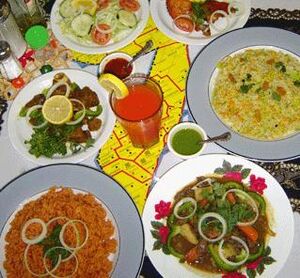
Somali cuisine is an intricate and diverse fusion of a multitude of culinary influences, drawing from the rich tapestry of Arab, Indian, and Italian flavours. This culinary tapestry is a direct result of Somalia's longstanding heritage of vibrant trade and bustling commerce.
The essential components that form the foundation of Somali dishes encompass staples like rice and pasta, along with an extensive selection of meats ranging from lamb to beef and chicken. Aromatic spices such as cumin, cardamom, and coriander are frequently utilized to infuse dishes with tantalizing flavors.
The culinary landscape of Somali cuisine also boasts an impressive assortment of hearty stews, traditional flatbreads, and delectable pastries, with highlights like the beloved "Canjeero/Lahooh," a delightful variation of the tangy fermented pancake-like flatbread that is savoured not only in Somalia but also in its neighbouring countries like Ethiopia, Eritrea, and Yemen.
Additionally, a distinctive feature of Somali culinary tradition is the incorporation of camel meat and milk. They are considered a delicacy and serve as cherished and fundamental elements in the rich tapestry of Somali cuisine.
Somali rice, the usual staple for dinner or lunch, is typically seasoned and mixed with various ingredients such as meat, vegetables, and, in a somewhat unique manner, raisins, adding a sweet note to the dish. Also, it is not uncommon for this dish to be presented in a visually appealing manner by incorporating multiple colors, as certain portions may be artificially tinted with shades of yellow or orange using saffron and other spices to enhance its aesthetic appeal.
An enduring testament to the influence of Italian colonial rule in Somalia is the widespread adoption of pasta and lasagne in the local culinary landscape, espicially in the south, showcasing how these dishes have seamlessly integrated into the traditional diet alongside rice.
Tea and coffee, both well-loved beverages, are also really popular. Among the early adopters of coffee consumption were the Somalis, who have the historical distinction of being among the first individuals documented to have enjoyed this stimulating drink. Additionally, Somali merchants played a pivotal role in the global coffee trade, being one of the first to export coffee beans. The unique Somali coffee, known locally as 'Qahwo' and tea 'Shah', stand out due to their preparation method which involves a blend of various spices meticulously selected to enhance their rich and complex flavor profile.
'Xalwo', which is closely associated with Omani 'Halwa', is a smooth jelly-like treat that is made with a blend of spices, seeds, nuts, and caramelized sugar. This delightful confection is well-loved in Somalia and is commonly served together with Somali 'Qahwo'. After meals, homes are traditionally perfumed using frankincense or incense (unsi), which is prepared inside an incense burner referred to as a dabqaad.
Music
Somalia has a rich musical heritage centred on traditional Somali folklore. Most Somali songs are pentatonic. That is, they only use five pitches per octave in contrast to a heptatonic (seven note) scale like the major scale. At first listen, Somali music might be mistaken for the sounds of nearby regions such as Ethiopia, Sudan or the Arabian Peninsula, but it is ultimately recognizable by its own unique tunes and styles. Somali songs are usually the product of collaboration between lyricists (midho), songwriters (laxan) and singers (codka or "voice").
Architecture

Somali architecture is a rich and diverse tradition of engineering and design. Spanning the country's ancient, medieval and early modern periods, it also embraces the fusion of Somalo-Islamic architecture with contemporary Western designs.
In ancient Somalia, pyramidical structures known in Somali as taalo were a popular burial style, with hundreds of these dry stone monuments scattered around the country today. Houses were built of dressed stone similar to the ones in ancient Egypt. There are also examples of courtyards and large stone walls enclosing settlements, such as the Wargaade Wall.
The adoption of Islam in Somalia's early medieval history brought Islamic architectural influences from Arabia and Persia. This stimulated a shift in construction from dry stone and other related materials to coral stone, sun dried bricks, and the widespread use of limestone in Somali architecture. Many of the new architectural designs, such as mosques, were built on the ruins of older structures, a practice that would continue throughout the following centuries.
Images for kids
-
Men from Punt carrying Gifts, Tomb of Rekhmire.
-
The Silk Road extending from China to southern Europe, Arabia, Somalia, Egypt, Persia, India, and Java.
-
The Ajuran Sultanate maintained commercial ties with the Ming dynasty and other kingdoms.
-
Mogadishu, capital of Italian Somaliland, with the Catholic Cathedral at the center and the Arch monument in honor of King Umberto I of Italy.
-
An avenue in downtown Mogadishu in 1963.
-
Major General Mohamed Siad Barre, Chairman of the Supreme Revolutionary Council, meeting with President of Romania Nicolae Ceauşescu.
-
Air Somalia Tupolev Tu-154 in Sharjah, United Arab Emirates. Somalia today has several private airlines
-
500 Somali shilling banknote
-
The Citadel of Gondershe
See also
 In Spanish: Somalia para niños
In Spanish: Somalia para niños





